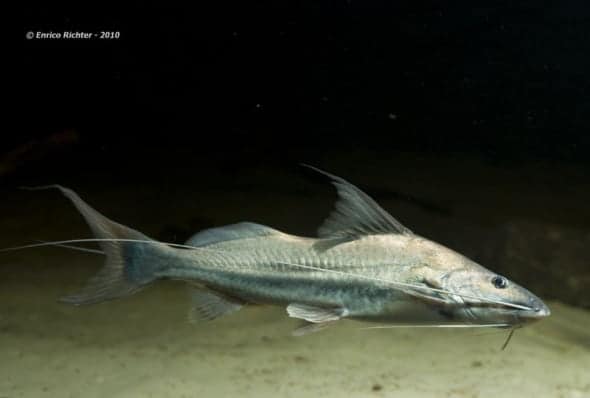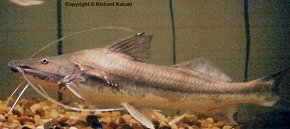
Manitoa (Brachyplasystoma vaillanti) is a freshwater species belonging to the catfish group, widely distributed in the Amazon River basin and the rest of South America.
It has several common names: manitoa, pirabutón(Colombia), piramutaba(Brazil), and blanco pobre in some parts of the Amazon.
Features
Catfishes, which comprise about 300 species, are characterized by a depressed body, a large and long head, small and bulging eyes, spines on the fins and, their most distinctive feature, the presence of long maxillary barbels.

Enrico Richter / PD
It belongs to the family Pimelodidae. It is a large, tropical demersal species, with a hydrodynamic body, with a length up to 1.5 meters.
It is a bottom-dwelling fish, with nocturnal habits. It is a species without scales, which is popularly known as leather species, as catfish are generally called.
Adults have a long, well-developed adipose fin.
It has a grayish coloration on the back and whitish on the belly. Its head is long and flattened, its eyes are small and it has long, flattened maxillary beards. Its upper jaw is slightly larger than the lower jaw.
In the Amazon, the manitoa is found in large rivers, such as the Ucayali, Marañon, Amazon, Napo and Putumayo.

Manitoa Food
It is a very voracious, piscivorous fish that feeds on small fish, preferably those with a fusiform body.
Manitoa Reproduction
It is a migratory fish. It reproduces during the months of November and December, when the period of river flooding begins. During that time it moves in large shoals in the main channel of the rivers.
Nutritional value
Its caloric value is 69 to 141 kcal per 200 g of edible part. Its fat content is low, around 0.86 and 8 %, depending on the season, but it is a high quality fat, rich in monounsaturated fatty acids (oleic, palmitoleic) and polyunsaturated linoleic.
Although it is relatively high in protein, which fluctuates between 15.3 and 17.7%. The specimens caught in the Puerto Maldonado area have mercury values of 0.581 pp, close to the permissible limit for human consumption.

Loopy30 / CCbySA
Commercial importance
The list of the main species caught in commercial fishing includes the manitoa, especially in the landings of the fishing ports of the Lower Amazon and Putumayo rivers.
The manitoa, like all species of the catfish group, has a high commercial value due to the excellence of its meat, although it is also exploited as an ornamental fish in its juvenile stage.

Dr. Rafael Cartay is a Venezuelan economist, historian, and writer best known for his extensive work in gastronomy, and has received the National Nutrition Award, Gourmand World Cookbook Award, Best Kitchen Dictionary, and The Great Gold Fork. He began his research on the Amazon in 2014 and lived in Iquitos during 2015, where he wrote The Peruvian Amazon Table (2016), the Dictionary of Food and Cuisine of the Amazon Basin (2020), and the online portal delAmazonas.com, of which he is co-founder and main writer. Books by Rafael Cartay can be found on Amazon.com
This post is also available in:
![]() Español (Spanish)
Español (Spanish)
